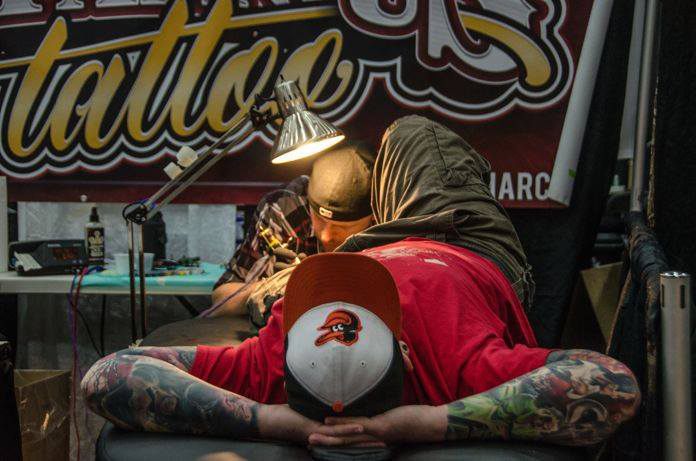News & Community
The Chatter: July 2015
Overheard at the tattoo convention, Spincycle laundromat, and LGBTQ walking tour.
Beauty Marks
West Pratt Street
April 11, 2015
Mötley Crüe’s glam metal hit, “Girls, Girls, Girls,” blares as the Miss Tattooed Baltimore pageant gets underway at the 8th Annual Tattoo Arts Convention. Twenty contestants, a pleasingly diverse group in terms of age, ethnicity, size, and shape—not to mention personal style—take the stage in everything from neon bikinis and low-cut, gothic gowns to hip retro dresses their grandmothers may have worn.
As amateur paparazzi snap away, the crowd, many sipping cans of Natty Boh, cheer for friends and loved ones—including two parents wildly rooting for their heavily tattooed and pierced twentysomething daughter. “Why wouldn’t we support her?” says Dad. “She’s in college. She’s doing great.”
After rounds based on tattoo quality and quantity, and then overall beauty presentation, the women, whose careers vary from arts education to firefighting, talk a little about themselves. Ultimately, beautician and mom Valerie Stanovich, 26, channeling an edgy, pin-up “Norma Jean” look in cowgirl boots and red-and-white-checked top—while rocking full-sleeve arm, thigh, and neck tattoos—is named the winner. Stanovich, who also runs a small company called Vintage Veils, plans to volunteer with Brides Against Breast Cancer during her reign and will make various local appearances, including emceeing HonFest’s mustache contest. Along with $1,500 in prizes, she also receives a tiara, of course, to wear for the year—though not last year’s winner, Lindsey Crozier’s, sparkling headpiece.
“Oh no,” Crozier says with a smile after placing the jeweled crown atop Stanovich’s done-up, brunette locks, in accordance with traditional pageant practice. “This is a different one. I get to keep mine.”
Life Cycles
Maryland Avenue
May 3, 2015
Baskets of clothes sit atop washing machines inside the packed house at the Spincycle laundromat in lower Remington. Many people here have come intending to do laundry, naturally, but others have come to catch a pop-up music and art exhibition called “Love on the Line: Dirty Laundry.” Some have come to do both.
“We encouraged everyone to bring quarters and a load to wash,” chuckles Melani Douglass, founder of the traveling Family Arts Museum, which is presenting the exhibition. The idea, explains Douglass, who earned a master’s degree in curatorial practice this spring from Maryland Institute College of Art, is “to celebrate the ancient forms, everyday rituals, prescriptions, and tonics for getting the stains out of laundry and life.”
Surrounded by decorated mannequins, poet Femi the DriFish reads beneath colorful portraits, hung with clothespins, painted by artist Pierre Bennu. There’s also Brazilian dance and a performance by vocalist Jasmine Pope of J. Pope and Funk Friday. “We are the ones we’ve been waiting for,” she sings, a nod to the still reverberating Freddie Gray protests.
Nearby, the show’s “domestic artist in residence,” Ms. Penny, who works at Spincycle, cleans and folds clothes, as a volunteer collects “recipes” for removing stains of both the fiber and emotional variety. “Sometimes all you need is a gentle wash, other times you need bleach. And sometimes, you need a professional,” she says.
“You can also learn a lot about people from their laundry,” adds Adonna Nissi, a member of the all-ages Baltimore Girls collective, with a smile. “You might see a middle-aged woman doing her wash, or a mom doing her kid’s clothes, and assume you know everything about their situation. Then, you’ll see her pulling out a sexy pair of underwear and you realize, ‘Oh, she’s got something going on.’”
Rainbow Warriors
North Charles Street
May 31, 2015
The nearly 40-year-old Gay, Lesbian, Bisexual, Transgender Community Center of Baltimore (GLCCB) moved into the Waxter Center last year, so it’s appropriate that Baltimore Heritage’s LGBTQ Walking Tour begins here. Beyond the neighborhood’s gay bars and restaurants, Mt. Vernon has long been home to gay-friendly institutions, activist Richard Oloizia notes, including the Waxter Center, which since 1991 has hosted the Chesapeake Squares—Baltimore’s gay-friendly square-dance club—and the Emmanuel Episcopal Church, which first screened John Waters’s notorious Pink Flamingos.
Across the street, Oloizia points out the old apartment of John Stuban, the founder of ACT UP Baltimore, who died of AIDS in 1994, and then Leon’s, a gay bar since 1957, which for decades maintained a second, hidden entrance through the straight restaurant located behind it.
At Mount Vernon Place, Oloizia recalls the city’s first “pride” marches and retired college professor Shirley Parry tells of the local lesbian women who founded the Bryn Mawr School for girls and secured the rights of women to attend The Johns Hopkins University School of Medicine.
The 90-minute tour ends near the Hippo, the popular disco that’s set to become a CVS, and the row house where Gertrude Stein lived when she attended Hopkins. Kate Drabinski, a University of Maryland Baltimore County gender and women’s studies lecturer, says Stein faced misogyny at med school, which she wasn’t great at—she was a writer, after all—but that this is where she first fell in love with a woman and suffered her first heartbreak. “She lived down the street there, but please don’t go knock on the door because other people live there now, and that would be awkward,” Drabinski cautions. “From experience.”
